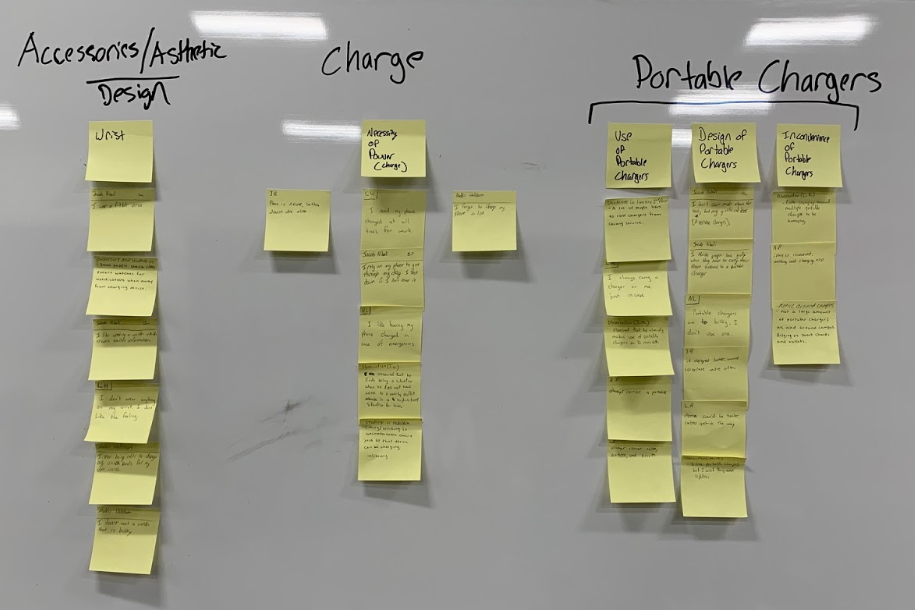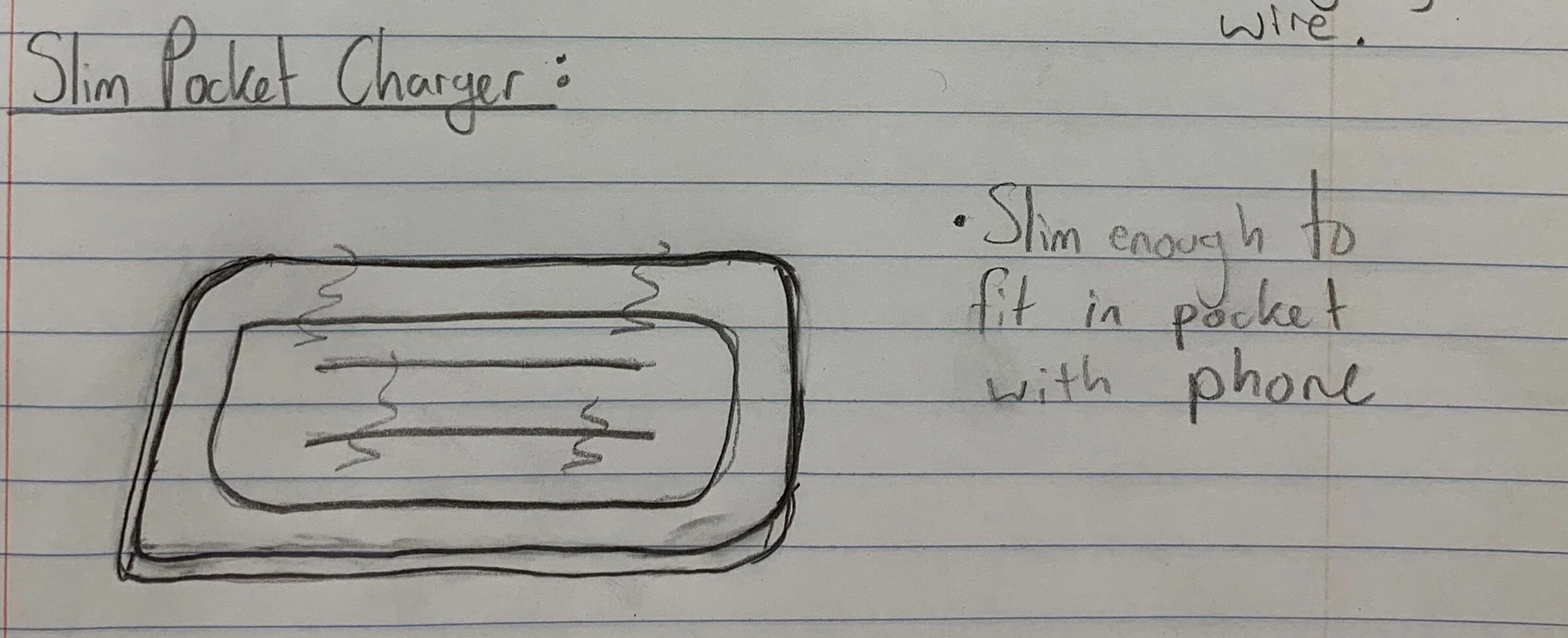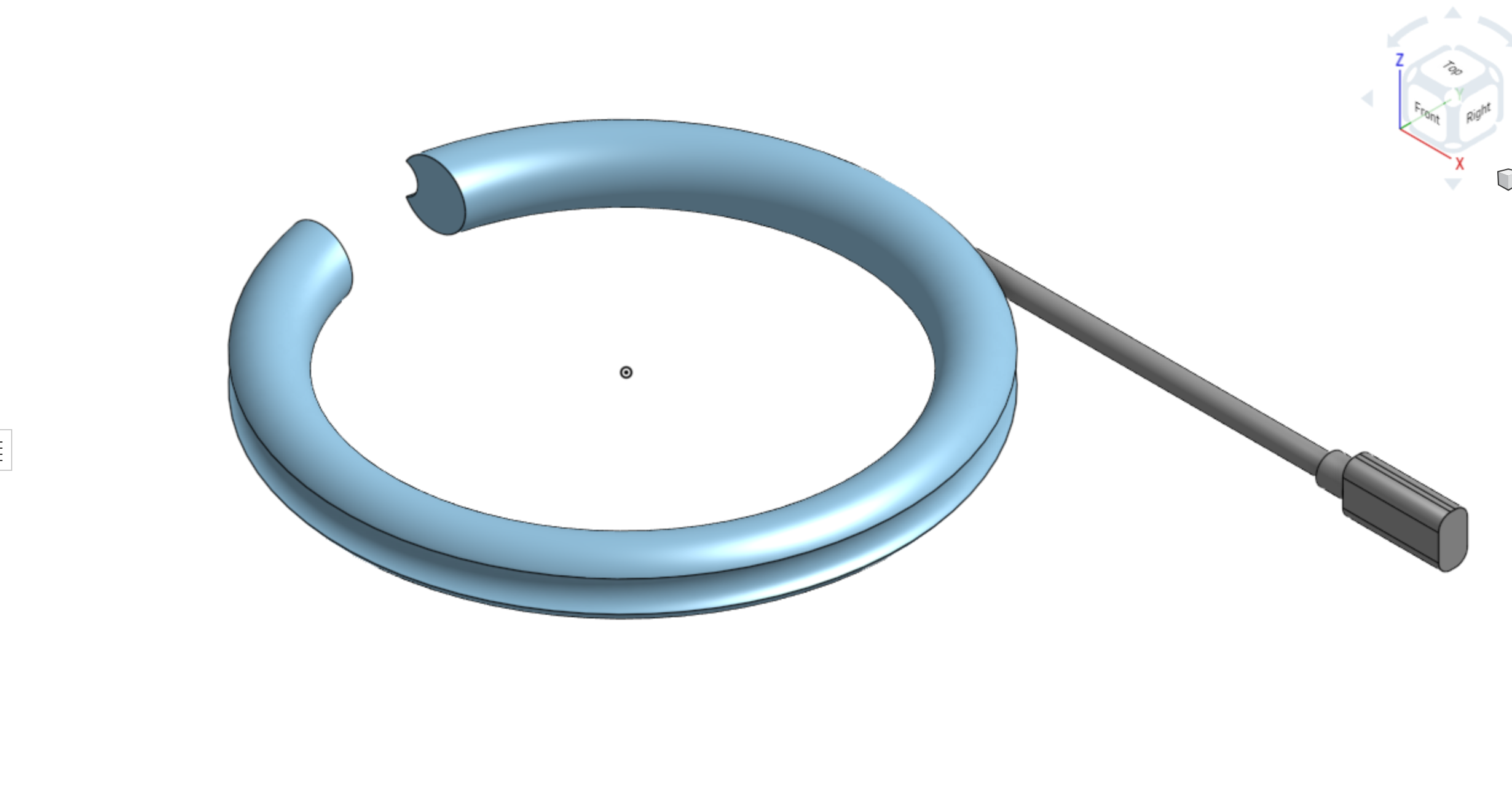University of Maryland, College Park
User-Centered Design Project
Designing smartphone charger based on qualified user research
↓
The Problem
Sometimes you forget to charge your device, and are left with a brick until you can find an outlet. This happens far too often, and can happen to anybody. At school, the office, out running errands, name your place, and you could run the risk of having a dead battery.
The Solution
Portable chargers that you are able to wear. No more carrying around bulky power bricks, worrying about where to put it. No more concern of creating an eyesore of wires when charging.
Stakeholders
Students
Don't let a dead battery ruin your class.
Enthusiasts
Stylish technology that enables you to enjoy your devices for longer.
Professionals
A charge always at your fingertips, ready to boost you through a presentation.
WAAD
When building our WAAD, we sat down and discussed each of the data points that we collected and determine the most relevant to creating our design. After analyzing the entire groups work notes, we chose overarching headings that were appropriate for sorting each sticky note. There were a few work notes that we noticed would fit into more than one group so we put them in between both groups. For the most part, there were definitive groups for each work note. When completed, we conversed and uncovered new information for the next step in our design process.
Contextual Inquiry
For our interview preparation, we discussed a number of questions that we wanted to definitely include in our conversation with the subject. These became the cornerstone of each of our interviews. Then, we decided on general topics and points of interest that we aimed to bring up during the interview with the person. By creating a set of only a few imperative questions to ask in every interview, it left room for more of a fluid interview and provoked the interviewee to share anecdotes and other personal experiences they may have with us. Because of how common the activity we are gathering data on is, we wanted to create an environment of an open conversation about using chargers and how they felt about our solutions. In terms of the observations, our group wanted to ensure that we were all constantly looking for anything that stood out or for common trends. Our preparation for this data collection method was to hold each of our group members responsible for sharing at least one observation each class day.
McKeldin Library:
We interviewed students who seemed uncomfortable with the way they were forced to charge their device (tethered to outlets) as well as the employees that rent out chargers and devices on the second floor media center. By doing so we could collect data about students and how/when they charge their devices during their study sessions.
Stamp Student Union:
We decided Stamp would be a great place for raw data collection as well because it is a place for all different types of activities. This way, we could broaden our audience and observe/interview different types of students and staff members.
Classroom:
Finally, we chose to constantly observe charging behaviors throughout our daily activities because of how common the action is. There are plenty of observations to record on a daily basis
Initial Designs
Design 1: Power Band
Design 2: Wireless Charge Card
Persona
Goals:
Not having to constantly worry about the battery life of his device.
Main tasks:
Charging phone prior to use.
Usage stories:
Forgot to bring his phone charger from home, phone died because he did not have a spare charger.
Stranded in McKeldin while studying, forgot to charge phone, couldn’t meet up with study-group.
Problems encountered in work practice:
Phone battery depleting.
Phone battery dead when I need it.
Concerns:
Needs phone for communication throughout the day communicating with study groups.
Biggest barriers of their work:
Not being able to communicate with others.
Jake Melch
Male
20 years old
Sophomore: Chemical Engineering Major
iPhone User
Pilot Test
Power Band
Walking through how to use the Power Band, the user places it around their preferred wrist, and secures it with the clasp (in this prototype it is just adhesive). Once the wrist band is secured to the wrist, the user can adjust the position of the band if needed. To accomplish a charge, the user presses the power button, which lights up the battery charge indicator to the left of the button. This indicates to the user that is is ready for use and has a charge available. The user then untethers the charge cable and plugs it into their device, enabling them to charge on the go. The battery indicator lights will blink as the device charges, indicating it is charging and the remaining battery level. Once finished, the user can store the cord back on the band, ready for its next use. When the band needs to be charged itself, it is taken off, and plugged into a USB type C connector on the side of the band. When it is fully charged, all of the battery indicators will be lit.
Wireless Charge Card
For users to use the Charge Card, they first press the power button, which will illuminate the battery level indicator, showing the charge level that is remaining. Once powered on, the user will place the back of their wireless charging cable phone on the Charge Card, and small magnets embedded in the corners will gently align the device to center the wireless charging coils. Wireless charging through Qi charging will begin automatically, and the user's device is now charging. The user can remove their mobile device from the Charge Card whenever they please, and the wireless charging will stop, and the Charge Card will remain in a standby state, waiting for the user's device to be replaced on the coil.
To use the Charge Card as a charging pad, the user may plug a USB type C connector into the charging port, and the device will automatically begin charging, and allow wireless charging of mobile devices. The device does not need to be manually turned on for this functionality to work, as the added power to the charge port will automatically wake the Charge Card.
Digital Prototypes
Charge Card
Power Band
Evaluation
Being that we have a physical object, that has the main intention to be interacted with the least in order to accomplish the task, we opted to focus our evaluation on rich qualitative data, which focuses more about the user experience, whether the experience seemed clunky, how easily they could accomplish their task of charging their phone, and other insight like that. While we could incorporate quantitative data through Likert scales in a survey, we would need qualitative opinions in order to fully understand why certain criteria was scored as it was.
Our evaluation technique was based on think alouds, as users talk us through their experience. In order to understand just how well our charging devices meet user needs, we need to ensure that even first time users are capable of easily using the device without any additional effort in attempting to understand how it works. While we did not include questionnaires/ surveys in our evaluation technique, if this was a larger scale test, we would consider including both in hopes that we would get some richer open-ended responses as well as some quantitative data as well to allow us to improve certain features, such as magnet strength, size of device, and charging capacity.







